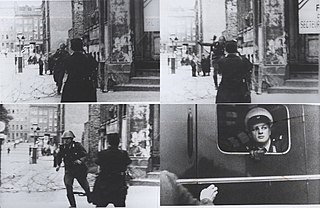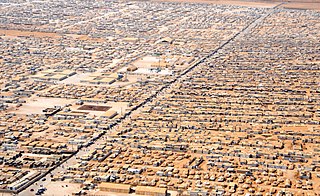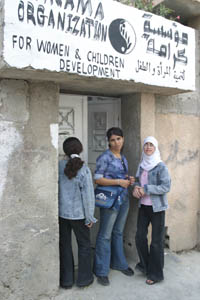The United Nations High Commissioner for Refugees (UNHCR) is a United Nations agency mandated to aid and protect refugees, forcibly displaced communities, and stateless people, and to assist in their voluntary repatriation, local integration or resettlement to a third country. It is headquartered in Geneva, Switzerland, with over 18,879 staff working in 138 countries as of 2020.

A refugee, conventionally speaking, is a person who has lost the protection of their country of origin and who cannot or is unwilling to return there due to well-founded fear of persecution. Such a person may be called an asylum seeker until granted refugee status by the contracting state or the United Nations High Commissioner for Refugees (UNHCR) if they formally make a claim for asylum.
Palestinian refugees are citizens of Mandatory Palestine, and their descendants, who fled or were expelled from their country over the course of the 1947–1949 Palestine war and the Six-Day War. Most Palestinian refugees live in or near 68 Palestinian refugee camps across Jordan, Lebanon, Syria, the West Bank and the Gaza Strip. In 2019 more than 5.6 million Palestinian refugees were registered with the United Nations.

A refugee camp is a temporary settlement built to receive refugees and people in refugee-like situations. Refugee camps usually accommodate displaced people who have fled their home country, but camps are also made for internally displaced people. Usually, refugees seek asylum after they have escaped war in their home countries, but some camps also house environmental and economic migrants. Camps with over a hundred thousand people are common, but as of 2012, the average-sized camp housed around 11,400. They are usually built and run by a government, the United Nations, international organizations, or non-governmental organization. Unofficial refugee camps, such as Idomeni in Greece or the Calais jungle in France, are where refugees are largely left without the support of governments or international organizations.

Refugees of Iraq are Iraqi nationals who have fled Iraq due to war or persecution. Throughout 1980 until 2017, there were a large number of refugees fleeing Iraq and settling throughout the world, peaking with the Iraq War and continued until the end of the most recent War in Iraq (2013–2017). Precipitated by a series of conflicts including the Kurdish rebellions during the Iran–Iraq War, Iraq's Invasion of Kuwait (1990) and the Gulf War (1991), the subsequent sanctions against Iraq (1991–2003), culminating in the Iraq War and the subsequent War in Iraq (2013–2017), millions were forced by insecurity to flee their homes in Iraq. Like the majority of refugees worldwide, Iraqi refugees established themselves in urban areas in other countries rather than in refugee camps. In April 2007, there was an estimate of over four million Iraqi refugees around the world, including 1.9 million in Iraq, 2 million in neighboring Middle East countries, and around 200,000 in countries outside the Middle East. The United Nations High Commissioner for Refugees (UNHCR) has led the humanitarian efforts for Iraqi refugees. The Iraqi displacement of several million was the largest in the Middle East at the time, and was even larger than the number of Palestinians who were displaced in 1948 during the creation of the state of Israel.
Iraqis in Lebanon are people of Iraqi origin residing in Lebanon and Lebanese citizens of Iraqi ancestry. Statistics for Iraqi refugees in Lebanon vary, but typically put the number at around 50,000.

The Iraqi diaspora refers to native Iraqis who have left for other countries as emigrants or refugees, and is now one of the largest in modern times, being described by the UN as a "humanitarian crisis" caused by the 1991 Gulf War and 2003 invasion of Iraq and by the ensuing war.
The Iraqi diaspora in West Asia is mostly located in Syria, Jordan, Iran and Lebanon, in addition to the well established numbers in the Persian Gulf states and Israel. As a result of the Iraq War, the Iraqi refugee crisis is the largest in West Asia in 60 years, since 1948 when the State of Israel was established.
Since the late 1970s until the present, Iraq has witnessed numerous waves of refugees and emigrants due to significant events in its modern history. These events have led to the displacement of millions of Iraqis. These include over three decades of repression, periodic violent attacks, and massacres targeting the Kurdish population in the north and the Shi'a in the south, all carried out by Saddam Hussein's regime. Other factors include the Iran-Iraq War (1980-1988), the Gulf War of 1991, the prolonged economic sanctions until the overthrow of Saddam Hussein, and the 2003 US-led invasion of Iraq.
Iraqis in Syria are Syrian citizens of Iraqi origin and Iraqi residents in Syria.
Iraqis in Jordan are estimated to number approximately 131.000.
The Iraq War resulted in multiple humanitarian crises.
Al-Waleed is a makeshift Palestinian refugee camp in Iraq, near the border with Syria and the al-Tanf Crossing, and not far from the border with Jordan. It was set up in 2006 by Iraqi-Palestinian and Iraqi refugees stranded at the Iraqi–Syrian border. The United Nations High Commissioner for Refugees has two field staff stationed in the camp. In 2008, it had a population of 1,649 refugees, 1,602 of whom were Palestinians and the remainders Iraqis.
Refugees of the Syrian Civil War are citizens and permanent residents of Syria who have fled the country throughout the Syrian Civil War. The pre-war population of the Syrian Arab Republic was estimated at 22 million (2017), including permanent residents. Of that number, the United Nations (UN) identified 13.5 million (2016) as displaced persons, requiring humanitarian assistance. Of these, since the start of the Syrian Civil War in 2011 more than six million (2016) were internally displaced, and around five million (2016) had crossed into other countries, seeking asylum or placed in Syrian refugee camps worldwide. It is often described as one of the largest refugee crises in history.

Syrian refugee camp and shelters are temporary settlements built to receive internally displaced people and refugees of the Syrian Civil War. Of the estimated 7 million persons displaced within Syria, only a small minority live in camps or collective shelters. Similarly, of the 8 million refugees, only about 10 percent live in refugee camps, with the vast majority living in both urban and rural areas of neighboring countries. Beside Syrians, they include Iraqis, Palestinians, Kurds, Yazidis, individuals from Somalia, and a minority of those who fled the Yemeni and Sudanese civil wars.

Palestinians in Syria are people of Palestinian origin, most of whom have been residing in Syria after they were displaced from their homeland during the 1948 Palestinian expulsion and flight. Palestinians hold most of the same rights as the Syrian population, but cannot become Syrian nationals except in rare cases. In 2011, there were 526,744 registered Palestinian refugees in Syria. Due to harsh conditions, the number of registered refugees has since dropped to about 450,000 due to many Palestinians fleeing to Lebanon, Jordan or elsewhere in the region to escaping to Europe as refugees, especially to Germany and Sweden.
Syrians in Lebanon refers to the Syrian migrant workers and, more recently, to the Syrian refugees who fled to Lebanon during the Syrian Civil War. The relationship between Lebanon and Syria includes Maronite-requested aid during Lebanon's Civil War which led to a 29-year occupation of Lebanon by Syria ending in 2005. Following the outbreak of the Syrian Civil War, refugees began entering Lebanon in 2011. Lebanon's response towards the influx of refugees has been criticized as negative, with the Lebanese government leaving them undocumented and limited and attacks on Syrian refugees by Lebanese citizens which go unaddressed by authorities. Despite the strained relationship between the Syrians and Lebanese, taking into consideration only Syrian refugees, Lebanon has the highest number of refugees per capita in the world, with one refugee per four nationals. The power dynamic and position of Syria and Lebanon changed drastically in such a short amount of time, it is inevitable that sentiments and prejudices prevailed despite progressions and changes in circumstance.
A refugee crisis can refer to difficulties and dangerous situations in the reception of large groups of forcibly displaced persons. These could be either internally displaced, refugees, asylum seekers or any other huge groups of migrants.
Rukban, sometimes transliterated Rakban, Arabic (الرُّكبان) or is an arid remote area on the Syrian border near the extreme northeast of Jordan, close to the joint borders with Syria and Iraq.
Violence against Palestinians in Iraq was a series of attacks, persecution, eviction, expulsion, harassment, rape, and killings of Palestinians in Iraq after the Fall of Saddam.









